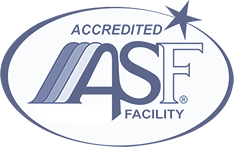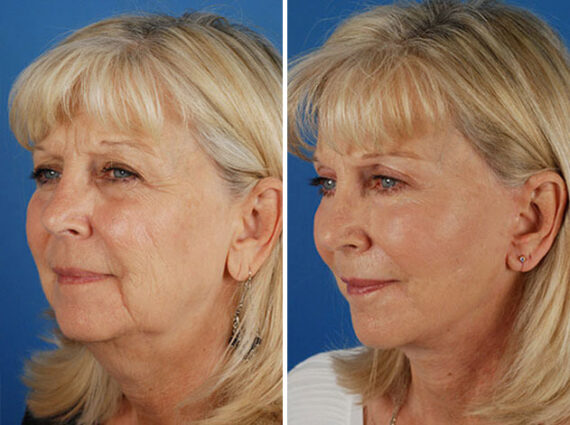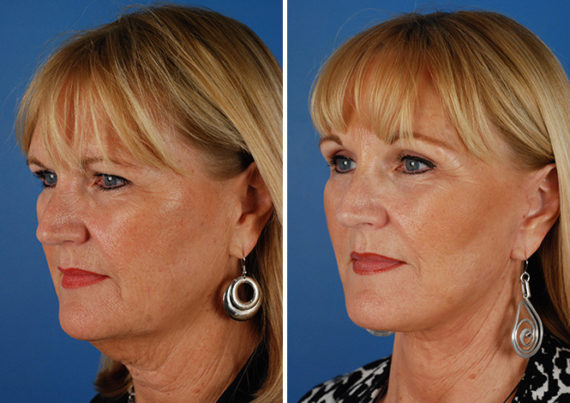Rediscover Radiance with Midface Lift Benefits
A Midface Lift is a sophisticated procedure designed to rejuvenate the central section of the face. It specifically targets the area around the cheeks and below the eyes, which often shows early signs of aging. This treatment lifts and repositions the facial tissues, providing a more youthful and refreshed appearance while maintaining natural facial expressions.
Our Achievements
A mid-facelift is a procedure that can dramatically improve the appearance of your face, giving you a more youthful and refreshed look. Using minimally invasive techniques, this innovative procedure can provide amazing results. Read on to learn more about what an endoscopic mid-facelift is and how it works.
According to the American Society of Plastic Surgeons, over 10,000 mid-facelifts were performed in the United States in 2022. This number is an increase of 4% from the previous year, showing that this procedure is becoming increasingly popular among those looking to reduce signs of aging and enhance their facial appearance. Endoscopic mid-facelifts offer limited downtime and as such, they are becoming more widely accepted as a safe and effective way to improve facial aesthetics.
What is a Mid-Facelift Procedure?
An endoscopic mid-facelift, also known as a cheek lift, is a minimally invasive procedure used to reposition soft tissue in order to achieve a more youthful appearance. It involves making small incisions in the scalp and inside the mouth under the upper lip, allowing for the use of an endoscope (a thin tube with a camera attached) to get a better view of the underlying facial structure. Through these incisions, the surgeon can then carefully manipulate and reposition the soft tissues of the face, giving it a more youthful look.
The endoscopic mid-facelift can also help to restore volume loss in the face due to aging while preserving natural facial expressions. This procedure is often used in conjunction with other facial plastic surgery procedures to achieve a more comprehensive and long-lasting result. As such, it is becoming increasingly popular as an effective way to reduce signs of aging and improve overall facial appearance.

What to expect in a Endoscopic Midface Lift Consultation
During a consultation, the patient should discuss specific procedure-related goals. It is important to bring a list of concerns and questions to the consultation.
Dr. Agarwal, Dr. Maloney, and Dr. Holmes will evaluate the patient’s facial shape and bone structure and will discuss the potential achievements of endoscopic mid-facelift surgery during the meeting. Dr. Agarwal, Dr. Maloney, and Dr. Holmes will focus on the patient’s primary aging concerns to identify the technique most likely to achieve the desired results.
This is not a one-size-fits-all surgery. There are various techniques used to perform mid-facelifts. Additional procedures may be required to achieve the patient’s desired results. Endoscopic mid-facelift is highly regarded for its effectiveness, reduced scar production potential, longevity of results because of the deep plane of suspension, and minimal incision approach.
If Dr. Agarwal, Dr. Maloney, or Dr. Holmes determine that the patient is a candidate for the surgery, they can book an appointment and will receive pre-surgical instructions.
A mid-facelift is not a mini-facelift. At the Aesthetic Surgery Center, our surgeons perform endoscopic mid-facelifts, which are designed to address sagging cheeks, temporal hooding of the outer eyebrows, and the jowls. Small incisions are made behind the hairline of the forehead, inside the mouth, and around the ears, which lead to very well-hidden mid-facelift scars that are difficult to detect. As the midface is often one of the first areas to age, this can be used for 50-year-olds, with no upper age limit. The mid-facelift is performed within many layers: under the periosteum, deep to the SMAS layer of the face, and under the skin. This multilayer suspension ensures that you will have a facelift that lasts for several years.
At your consultation, our plastic surgeons will discuss the incisions and scars, how long a mid-facelift lasts, facelift recovery, and instructions post-facelift. Our patient coordinator will show you multiple mid-facelift before and after photos, as we have numerous examples of our work. A formal cost proposal will be given to you based on what the surgeon has recommended at your initial consult. Though we wish that it were, there really is no facelift without surgery—an advertising term that is, in truth, referring to injectables. Scheduling a Consultation with Dr. Agarwal, Dr. Maloney, or Dr. Holmes at the Aesthetic Surgery Center is the first step in helping you to achieve your personal goals. We look forward to meeting you!
Endoscopic midface lift
Benefits of an Endoscopic Midface Lift
The mid-facelift procedure makes achieving a naturally refreshed, rejuvenated appearance possible by improving the “smile lines” (also known as melolabial and nasolabial folds and marionette lines), sagging or hollowed cheeks, and cheek volume loss. It vertically elevates and repositions sagging cheek and jowl pads to increase cheek volume and create a well-defined profile. For the female patient, the mid-facelift provides an excellent opportunity to “open” the outside corners of the eyes. The mid-facelift is a compliment for patients who have had traditional facelifts because it directly lifts the weightiness off the central portion of the face. Oftentimes, patients who have had prior lower face and neck lift procedures never had the midface lifted, giving a “Nike swoop” deformity. The endoscopic midface lift is used to lift the cheeks, which are often neglected or inadequately lifted during traditional facelift surgery.
The mid-facelift is also frequently used with other procedures, such as:
- Lower lid blepharoplasty to restore delicate skin and beauty.
- Endoscopic forehead and browlift to “open” the eyes and restore youthful facial balance.
- Fat injections to add facial volume and fill lines, offsetting the effects of sun, gravity, environmental stress, and aging.
- Dermal fillers to recreate the look of fresh, young-looking skin.
- Cheek implants to create fullness and contours associated with youthful beauty.
- Lower face and neck lift to address jowl formation and neck skin and muscle laxity.
An endoscopic mid-facelift returns youthful contours to the mid-face by shaping and lifting the patient’s cheeks. The result is a naturally refreshed appearance, often without the need for a complete facelift.

Midface Lift Before & After Photos
* Each patient is unique and individual results may vary.
The Mid-Facelift Cost
Facial plastic surgeons are specialists trained to perform cosmetic surgery, a surgical specialty that focuses on the aesthetic improvement of facial features. Facial plastic surgeons use advanced surgical techniques to produce natural-looking results while minimizing scarring and discomfort. With their expertise in facial anatomy, these doctors are highly qualified to perform endoscopic mid-facelifts and other cosmetic facial procedures. They understand how different techniques can be used to address specific issues, such as sagging skin or jowls. The experienced facial plastic surgeon will also assess the patient’s overall health condition prior to any procedure so as to minimize risks associated with surgery. With the help of a highly skilled facial plastic surgeon, patients can achieve their desired look with minimal downtime and excellent results. Because each patient is treated with an individualized approach, cost can vary and will be presented after your personal consultation with one of our facelift specialists.
The Endoscopic Midface Lift Candidate
A mid-facelift is a good fit for anyone who has noticed the first aging signs in the midface area. There is no age limit for the mid-facelift, but people in their 40s use it to maintain their youthful looks, while patients in their 50s to 80s use it most commonly as part of a full endoscopic facelift procedure.
The patient should have realistic expectations at the start. A candidate for the endoscopic mid-facelift needs to be in good general health. The patient should tell the doctor about any medicines the patient takes, including over-the-counter or herbal medicines. Some medicines, such as blood thinners, increase the patient’s risk of bleeding.
Before any endoscopic mid-facelift is performed, the patient’s medical history should be taken into consideration. This includes any previous surgery and any medications or supplements the patient is currently taking. The doctor will then discuss the procedure in detail and answer any questions before scheduling the outpatient procedure. During the outpatient procedure, intravenous anesthesia is administered in our AAAASF accredited operating room to ensure that the patient remains comfortable throughout. The endoscopic mid-facelift can usually be completed within 2–4 hours, depending on the extent of work being done, additional procedures, and how long it takes for the patient to recover from anesthesia.
Endoscopic Facial Plastic Surgery
Mid-Facelift Risks
Risks of Complications: Although the endoscopic mid-facelift is a relatively safe procedure, there are still risks of complications during and after the surgery. These may include excessive bleeding or swelling, pain or discomfort, loss of sensation in the face or neck area, numbness, infection or reaction to anesthesia. In rare cases, a patient can also experience permanent hair loss in the treatment area.
Loss of Volume: When performing an endoscopic mid-facelift, it is possible to lose some volume in the temporal region due to dissection proceeding through this area to approach the cheeks.
Nerve Damage: When performing an endoscopic mid-facelift, it is possible for nerves to be damaged, which could result in a limited range of motion in certain areas of the face. Any potential nerve damage must be discussed with your surgeon before deciding whether this procedure is right for you.
Infection: As with any surgical procedure, there is always a risk of infection which can occur anytime after surgery has been completed. Signs of infection include redness, warmth, swelling, and pain in the treatment area. Your surgeon should be made aware of any signs of infection so that they can take the necessary measures to treat it.
How is the Mid-Facelift Procedure Performed
The innovative endoscopic mid-facelift procedure is accomplished using the latest plastic surgery and skin restoration techniques. As a stand-alone procedure, it typically takes about two to three hours to perform. If coupled with other rejuvenating procedures, it will take longer. All procedures are performed in an accredited outpatient surgical facility. All of our physicians also have hospital privileges here in Naples, Florida.
Using deep intravenous anesthesia, Dr. Agarwal, Dr. Maloney, or Dr. Holmes make tiny incisions just behind the patient’s hairline, inside the upper lip, and above the ears. Fat pads and muscles are readjusted to former positions on the face. Any excess skin may be trimmed at this time. These surgical adjustments create a youthful heart-shaped face and a firm neckline.
Some patients use the midface procedure along with a full facelift to achieve their personal goals. Since no two patients are alike, the mid-facelift procedure is adjusted to meet each patient’s unique needs.
A fiber-optic camera system and tiny precision instruments guide Dr. Agarwal, Dr. Maloney, and Dr. Holmes. Broad incisions used in the past unnecessarily exposed facial tissues and increased recovery time.
Recent developments in facial surgery, including non-reactive supportive suture designs and minimal-incision endoscopic procedures, create natural-looking, never-overdone results. Skin, fat, and cheek muscles are drawn to a higher plane as a single unit, in a vertical manner.
Endoscopic mid-facelift complications are extremely rare but, as with any surgery, can include bleeding, infection, or nerve injury. Our surgeons monitor you closely in the post-operative period to ensure the best result possible. Mid-facelift cost is commonly requested, but this is based on the level of complexity of the case, which is determined at your individualized consultation. We invite you to have a consultation at our practice with one of our experienced endoscopic facelift surgeons.
Comparing Upper Facelift, Mid-Facelift, and Lower Facelift
Upper facelift, mid-facelift, and lower facelift are surgical procedures that help improve the appearance of aging facial features. Depending on age and desired results, different types of facelifts may be recommended.
An upper facelift is also known as a brow lift or forehead lift. It focuses on improving the appearance of drooping eyebrows and sagging skin in the upper part of the face. Small endoscopic incisions are made behind the hairline to allow access to the lower forehead, in a dissection plane just above the bone (subperiosteal plane). The tethered attachments of the brow to the upper orbital rim are released and the forehead tissues are then lifted up and suspended. The procedure can take anywhere from one to two hours, depending on how much work is being done.
A mid-facelift is designed to address issues in the mid-face area, such as sagging jowling or sagging cheeks, and to reduce the appearance of nasolabial folds (lines near the nose) and marionette lines (lines near the lips). There is no surgery that totally eliminates nasolabial folds. This procedure involves making incisions inside the mouth or around natural skin creases to access underlying muscles and fat pads. The surgeon then gently lifts and tightens these tissues before removing any excess skin to achieve a more youthful look. Mid-facelifts typically take between two and three hours, depending on how much work needs to be done.
A lower facelift focuses on the lower half of the face, including the neck and jowls. An incision is made near the hairline and extended down below the earlobe and behind the ears. The surgeon then lifts the deep plane facial muscular layer, which brings excess skin up around the ears, where it is removed. This improves sagging jowls, neck bands, and wrinkles in the lower part of the face. This procedure typically takes two to four hours, depending on the amount of work being done.
In choosing between upper, mid, and lower facelift procedures, it is important to discuss your goals with a qualified plastic surgeon. Your surgeon can help you determine which type of facelift will best address your individual concerns and provide the desired results.
The Mid-facelift Recovery
The recovery period after a mid-facelift takes about 2-3 weeks. Patients should plan to rest for the first few days following surgery and avoid any strenuous activities. Ice packs can be applied to reduce swelling and discomfort in the area. During the healing process, patients may experience some bruising and tenderness as well as numbness in the treated area. These symptoms should subside within a few weeks after the procedure.
In order to ensure optimal postoperative period results, it is important for patients to follow all post-operative instructions carefully. In addition to resting and avoiding strenuous activities, it is important that patients avoid any activities that may cause excessive strain on the face, such as bending over or lifting heavy objects. Patients should also wear sunscreen outdoors and limit their exposure to direct sunlight during recovery to prevent discoloration of the skin around the incision sites.
Most patients are able to return to work or other normal activities two weeks after an endoscopic mid-facelift procedure. The majority of residual bruising and swelling will resolve within two weeks of surgery, but some swelling will take an additional 3–4 months to resolve. As with any surgical procedure, it is important that patients listen closely to their surgeon’s instructions in order to ensure the best possible results.
Results of a Mid-Facelift
The mid-facelift is a cosmetic procedure designed to restore a youthful position and contours to the face. This procedure is minimally invasive and provides lasting results with minimal scarring. During the procedure, small incisions are made along the hairline, inside the mouth, and around the ears. The surgeon then lifts and tightens deep layers of tissue beneath the skin to restore a youthful appearance. Afterward, excess skin is removed, and sutures are placed to close any incisions.
The mid-facelift can be done as a stand-alone procedure or in combination with other facial rejuvenation procedures, such as a full facelift, for more comprehensive results. Patients can achieve natural-looking results without large incisions or extended recovery time using advanced techniques such as intravenous anesthesia and precision instruments guided by a fiberoptic camera system.
The endoscopic mid-facelift can help reduce wrinkles in the middle of the face, restore volume to cheeks that have become hollowed out due to aging, create contours that have been lost over time due to gravity or fat loss, reduce jowls around the jawline, minimize double chins caused by loose skin or fat accumulation in this area and much more. Results can be seen immediately and will continue to improve over time as the swelling subsides.
What Are Some Signs of Aging That a Facelift Can Fix?
What is the recovery like after a facelift?
Choosing the Right Endoscopic Mid Face Lift Surgeon
The right plastic surgeon to accomplish the endoscopic mid face lift is a matter of personal preference. Patients typically search for:
- An experienced plastic surgeon with plenty of experience with facial procedures specifically
- An extensive photo gallery of before and after results, demonstrating the types of results that are representative of your surgeon’s experience. In our practice, we stress the importance of natural results after plastic surgery.
- Enthusiastic client recommendations and references
- Patient-focused practice: the doctor listens to his or her patients. You feel that your questions and concerns are addressed.
- State-of-the-art, certified surgical facility
- Convenient location
Patients in search of endoscopic mid face lift surgery in Naples, FL should contact Dr. Agarwal, Dr. Maloney, and Dr. Holmes at the Aesthetic Surgery Center to learn more.
Why choose Aesthetic Surgery Center
Dr. Anurag Agarwal, M.D., F.A.C.S.
- Double board-certified facial plastic surgeon by the American Board of Facial Plastic and Reconstructive Surgery and the American Board of Otolaryngology – Head and Neck Surgery.
- Oral examiner and Board of Directors for the American Board of Facial Plastic and Reconstructive Surgery
- Former President of the Florida Society of Facial Plastic and Reconstructive Surgery
- Received his Doctor of Medicine at Philadelphia’s MCP-Hahnemann School of Medicine in 1999 and was elected to the Alpha Omega Alpha Honor Society.
- In 2016, Dr. Agarwal was honored at the annual American Academy of Facial Plastic and Reconstructive Surgery national meeting.
Richard W. Maloney, M.D., F.A.C.S.
- Double board-certified facial plastic surgeon by both the American Board of Facial Plastic and Reconstructive surgery and the American Board of Otolaryngology-Head and Neck Surgery.
- Served as chief investigator for numerous laser application systems for CO2, Argon, Nd:YAG, ER:YAG and Krypton lasers used in Facial surgery.
- Fellow American Academy of Facial Plastic and Reconstructive Surgery and American Academy of Cosmetic Surgeons
- Board-certified plastic surgeon by the American Board of Plastic Surgery.
- Attended medical school at UNMC (University of Nebraska Medical College).
- Was elected to the Alpha Omega Alpha Honor Society.
- Member of The Aesthetic Society, the Florida Medical Association, and Collier County Medical Society.
- General surgery residency at Loyola University Medical Center in Maywood, IL
- Plastic surgery residency at Cleveland Clinic Florida












